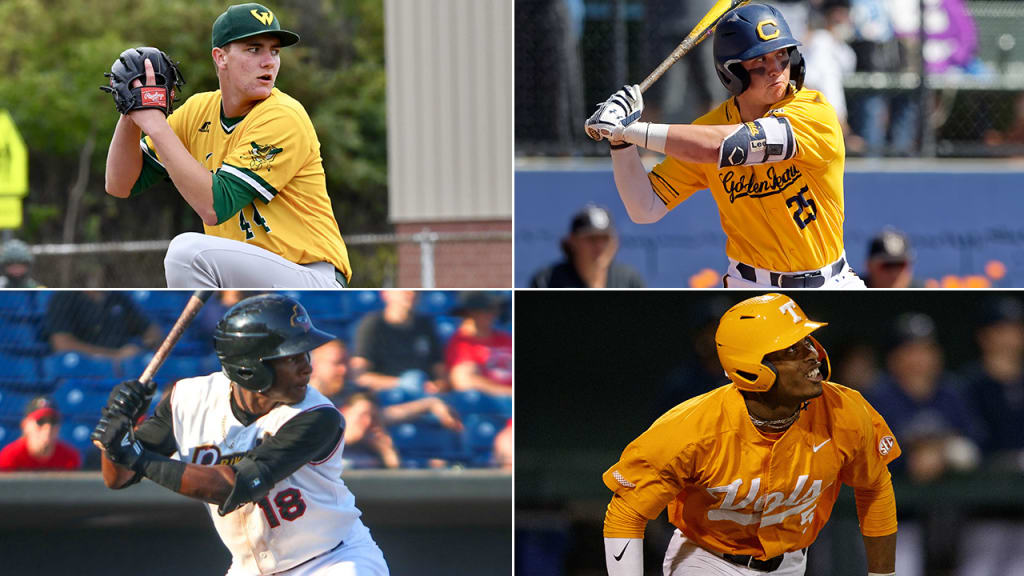
After the completion of the regular season and alternate training sites, most player development staffs have turned their attention to instructional league play. In the past, instructional leagues have been populated by new draftees, recent international signings and players at the bottom rungs of their organizational ladder. This year, in an attempt to make up for lost time due to the pandemic, it’s been expanded to include many more players. MLB Pipeline will be providing position-by-position reports from instructional league camps in Florida and Arizona.
Pitchers (27)
Hunter Brown, RHP (No. 6); Franny Cobos, RHP; Willy Collardo, RHP; Brett Conine, RHP (No. 23); Chad Donato, RHP; Jimmy Endersby, RHP; Cesar Gomez, RHP; Kyle Gruller, RHP; Ryan Gusto, RHP; Austin Hansen, RHP (No. 28); Jairo Lopez, RHP (No. 24); Juan Pablo Lopez, LHP; Angel Macuare, RHP; Zack Matthews, RHP; Jaime Melendez, RHP; Daniel Pacheco, RHP; Hunter Peck, LHP; Manny Ramirez, RHP; Jose Alberto Rivera, RHP (No. 14); Alex Santos, RHP (No. 7); Jayson Schroeder, RHP; Kyle Serrano, RHP; Jairo Solis, RHP (No. 8); Peter Solomon, RHP (No. 27); Jonathan Sprinkle, RHP; Misael Tamarez, RHP; Diosmerky Taveras, RHP
Right-hander Hunter Brown has gone from Division II Wayne State (Mich.) to one of the Astros' best pitching prospects in little more than a year. The 2019 fifth-rounder has a four-pitch arsenal and used his time in instructional league to continue to hone his curveball and changeup and to improve his control and command.
"Hunter has got some big-time stuff," Houston assistant GM in charge of player development Pete Putila said. "He's 96-98 mph with a huge curveball, a Tyler Glasnow-type curveball, an 86-88 mph slider and a changeup. He didn't throw the curveball until he got to us.
"It's really just a matter of refining his game, working on his locations and what-not. It's impressive watching him pitch. He gave our hitters fits."
Putila said righties Jairo Solis and Peter Solomon both looked strong as they continued their comebacks from Tommy John surgery, with Solis hitting 95 mph with his fastball on his final pitch of his final outing. Six pitchers posted their highest velocities ever, including nondrafted free agent Jimmy Endersby and 19-year-old Jaime Melendez touching 95.
Catchers (5)
Korey Lee (No. 5), Scott Manea, Nathan Perry, Nerio Rodriguez, C.J. Stubbs
Korey Lee was the biggest surprise pick in the first round of the 2019 Draft, but the Astros selected him 32nd overall because they believed in his well-above-average raw power and arm strength. Thus far his pro experience consists of 64 games in Short-Season ball and a brief appearance at the alternate training site this summer.
Lee bought a pitching machine for his home, so he was able to work on his hitting and receiving during his unexpected downtime this year after the Minor League season was cancelled. During instructional league, he focused on maintaining some mechanical changes at the plate Houston has had him make and also on improving his receiving ability.
"Korey has really refined his swing mechanics," Putila said. "He has quieted down his load and got his stride under control so he can use more of the middle of the field. Defensively, he looked really good. He shortened his arm action and was throwing everybody out and continued to refine his receiving."
Infielders (9)
Houston's top position prospect, shortstop Freudis Nova, made his full-season debut at age 19 last year and homered twice in his first five games in low Class A. But pitchers quickly realized they could exploit his aggressiveness and he went deep just one more time while batting .259/.301/.369.
Nova is both advanced for his age but also in need of at-bats against quality arms after the 2020 Minor League season never happened. There's no question that he has the tools (plus raw power, solid speed, double-plus arm) to become a star but he'll require significant polish before he can reach his ceiling.
"The big thing for him right now is to get him more at-bats against advanced pitching," Putila said. "The pitchers we had in camp had bigger velocities and good breaking stuff, so it was good for him. He's refining his plate discipline and approach. He's starting to physically mature without losing much in the way of foot speed."
Outfielders (11)
Area scouts weren't sure exactly what to make of Zach Daniels this spring. He batted just .176 with a 38 percent strikeout rate in his first two seasons at Tennessee, then hit .168 with a 44 percent whiff rate with wood bats in the Cape Cod League. But he got off to a torrid start as a junior, hitting .357/.478/.750 with 13 extra-base hits in 17 games before the season suddenly ended without giving him a chance to prove himself against better competition during Southeastern Conference play.
Though he's a potential 20-20 center fielder, his limited track record of success made him available to Houston in the fourth round of the Draft. He wowed the Astros with his tools during instructional league, posting huge exit velocities and displaying the best speed among position players in camp.
"The things he does are freakish," Putila said. "That's the only way how to describe it. He's as physically gifted as they come. His power-speed combination is pretty rare.
"He's continuing to refine his swing. He's starting his hands a bit higher so he has a smaller move to start. He's getting his first move ironed out so he can elevate the ball the way he needs to. It was really encouraging."
